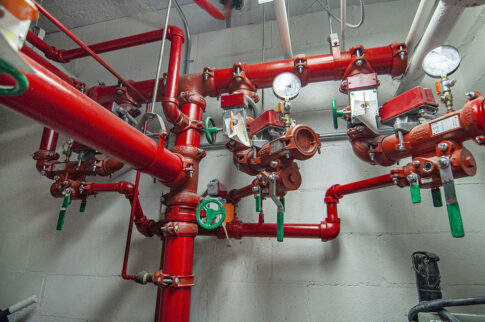Testimony to the Committee on Housing & Buildings and the Committee on Fire and Emergency Management Regarding Int. No 1146-B (Proposed Residential Fire Sprinkler Requirement)
December 2, 2020

Proposed residential fire sprinkler law Int. No 1146-B is well-intentioned, but problematic.
My name is Peter Varsalona; I am a NYS licensed professional engineer, and principal of RAND Engineering & Architecture, a design professional corporation based in New York City serving the professional engineering and architecture consulting needs of the residential cooperative and condominium industry.
I also serve on the Board of the Council of New York Cooperatives & Condominiums (CNYC Inc.), which is a membership organization providing information, education and advocacy for housing cooperatives and condominiums located throughout the five boroughs of New York City.
I am speaking today to voice opposition to Int. No 1146-B, which would require all existing residential buildings over 40 feet in height to be retrofitted throughout with fire sprinkler systems within a nine-year period, and to provide interim reports on the status of such installations, with penalties for non-compliance.
The bill unfairly groups all residential buildings over 40 feet into a single risk category, and fails to distinguish between fireproof (non-combustible) buildings constructed of concrete, masonry and steel, and non-fireproof (combustible) structures constructed wholly or partly of wood. The risk of flame-spread in fireproof buildings is significantly less than in a non-fireproof building.
For all unit owners, the disruptive impact to the interior of their apartments would be overwhelming – ceilings would need to be opened to permit installation of new sprinkler piping and heads, and drop ceilings would need to be added where none exist. Ceiling lights, fans, plumbing system piping, and mechanical vents would need to be relocated or removed in connection with this work. Residents may even need to vacate their apartments depending on the extent of these alterations.
Of particular importance, any new fire sprinkler installation mandates compliance to the 2014 NYC Construction Codes. For all residential building owners, the addition of a new sprinkler system would require extensive infrastructure improvements beyond the already extraordinary impact of the sprinkler branch piping, sprinkler heads and interior finish work in occupied housing that such a bill would mandate. The construction requirements for high-rise residential buildings (those that are greater than 125 feet in height) are frankly overwhelming:
This work with include, but not necessarily be limited to, the following:
- a dedicated fire or combined (fire/domestic) water service into the building would be required, along with required backflow prevention and metering equipment;
- the water storage tanks atop the older residential buildings are too small with only a 3,500 gallons reserve for fire standpipe use – a replacement or supplemental tank would be required to increase storage reserve to a minimum 15,000 gallons or more;
- the steel (dunnage) supports are insufficient to support this size of the enlarged tank or series of tanks, and would require reinforcement; also, reinforcement of the interior steel columns would be needed to accommodate this additional load;
- many buildings would require sprinkler booster pumps to increase water pressure at the uppermost floors;
- if the fire protection system becomes a combined standpipe/sprinkler system (in many instances this would be required), then you would need to install a fire pump, which has a large electrical requirement, often requiring electrical service upgrades to the building;
- a fire pump requires emergency power as a secondary power source. Emergency power would come in the form of a diesel-fired or natural gas generator; the existing gas piping system in the building isn’t sized for the generator consumption, so that would need to be upgraded. Or, if diesel fuel is used, day tanks and oil fill lines would be required;
- NYC does not allow voluntary or optional use generators – once installed they must also provide power to at least one elevator, emergency and exit lights, elevator cab lighting, pumps, etc. Equipment requiring emergency power would need to be separated from PL&P systems to receive power either from the utility meter or via a transfer switch connected to the generator system;
- a sprinkler system requires fire alarm notification; the fire alarm system in the building, if one even exists, would need to be upgraded or otherwise installed.
Although the installation of sprinklers throughout all residential buildings is well-intentioned, the use of sprinklers should not be seen as a fail-safe for preventing civilian deaths, injuries or damage that can occur during a fire, which are already near historic lows. Over the past 10 years, less than 90 fatalities have occurred in NYC each year due to structural fires. The use of fire-rated construction, prevalence and effectiveness of smoke and fire alarm systems, rapid Fire Department response times, adoption of the 2008/2014 NYC Construction Codes from its 1968 predecessor, and more modern building construction (with better fire-stop systems) have all greatly contributed to keep these numbers low each year.
For all of these reasons, we ask the City Council to strongly reconsider this bill in its entirety, as unnecessary, impractical, and unduly burdensome, at a time when New Yorkers can ill afford to implement it.
Thank you for this opportunity to express this viewpoint.
Sincerely,
Peter E. Varsalona, PE, CEM, CBCP
Principal, RAND Engineering & Architecture DPC
Board Member, Council of New York Cooperatives and Condominiums
Peter E. Varsalona, PE, CEM, CBCP is a principal and MEP Team Leader at RAND. He is also a board member on the Council of New York Cooperatives and Condominiums (CNYC). On December 2, 2020, Peter testified against Int. No 1146-B, New York City's proposed residential fire sprinkler requirement, at a public hearing held by the New York City Council's Committee on Housing & Buildings and Committee on Fire and Emergency Management.
